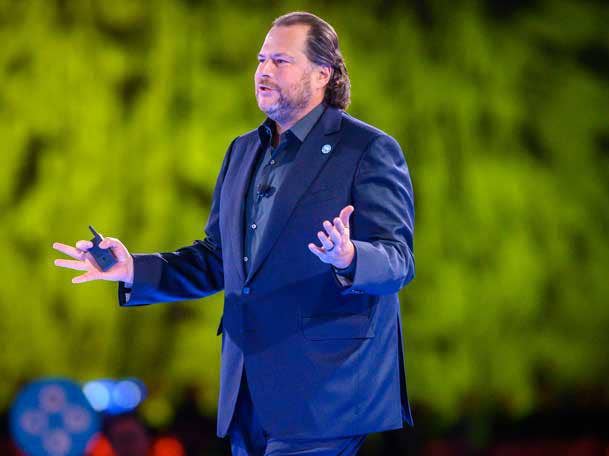Salesforce Q2 Earnings: 5 Takeaways
“This quarter was a continued testament to Salesforce’s resilience in this backdrop,” according to a Wedbush report.

Beating expectations, no short-term revenue growth from artificial intelligence, acquisitions on the horizon and praise for MuleSoft were some of the big takeaways from Salesforce’s reported earnings for the second quarter of its 2024 fiscal year.
The San Francisco-based customer relationship management (CRM) software vendor saw $8.6 billion in revenue for the quarter, above an expected $8.53 billion, according to a Thursday report from investment firm Wedbush.
The firm said that it believes “this quarter was a continued testament to Salesforce’s resilience in this backdrop with crushing the margin and expense profile story, continuing new investments in the shift to AI, and providing an impressive raised guidance to the year with operating margin expected to be ~30” percent, according to the report.
[RELATED: Salesforce CEO: We Are ‘Transforming From Being Not Only The No. 1 CRM, But To The No. 1 AI CRM’]
Salesforce Q2 Earnings Explained
Investment firm William Blair said in its Thursday report that “Salesforce’s second-quarter results surprised to the upside again as the company continues to deliver on its profitable growth strategy” with growth “proving to be more durable than the bears feared, which is a good recipe for success.”
Still, not all analysts were pleased with the results. A Thursday report from Bernstein pointed out signs of saturation in the vendor’s business.
Salesforce’s stock price at close of market Thursday was about $221 a share, up about 3 percent from Wednesday’s close.
Salesforce has about 11,000 partners, according to the vendor.
Read on for more takeaways from Salesforce’s second fiscal quarter earnings.

When Will AI Pay Off?
Benioff had plenty of bold proclamations for Salesforce’s AI prowess, saying the vendor is “at the dawn of an AI revolution” that will boost its classic CRM software offerings and spark “a massive tech buying cycle over the coming years.”
However, Salesforce CFO Amy Weaver told listeners that Salesforce’s “opportunities around AI”—along with price increases that took effect in August—do not have “a significant influence on our guidance for this year.“
In a Morgan Stanley report Thursday, the firm appreciated Benioff’s hints at AI-related Dreamforce announcements, but the CEO “fell short of outlining more detailed monetization plans.”
“While the company has spoken to expectations for monetization via a combo of seat-based uplift and consumption-based pricing, exact details of the consumption component of the equation remain the key unknown,” according to the Morgan Stanley report. “We are looking to Dreamforce to gain incremental clarity on this front, but believe it will ultimately be one to two years before generative AI is a meaningful contributor to the Salesforce model.”
Wedbush predicted that the vendor’s annual Dreamforce conference in September will “provide a large drive of growth pushing Salesforce further in its AI revolutionary path with the current transformation underway,” according to a Thursday report.
A Bernstein report Monday noted that Salesforce is hiring to boost its AI research and development (R&D), but “competing in AI is going to require resources, especially as they compete with Microsoft and to a lesser extent Oracle and SAP (who is getting help from Microsoft and Google).”
Bernstein expects more AI spending in the second half of the fiscal year. Salesforce executives also said that AI revenue opportunities won’t have a significant effect on the current fiscal year, according to the report.
“In fact, we wonder how well customers will recognize the value add offered by their GPT capabilities and how much they are willing to pay up for the service,” according to the report. “So far, only users of the Unlimited Edition can access GPT capability and with limited number of credits. We are concerned whether customers are willing to upgrade at a time of increased budget pressure on IT, as well as the competitive pressure from Microsoft.”
Bernstein said that, except for Microsoft, it will “take time for any of the AI offerings from any vendor … to generate meaningful revenues, especially when competition is already quite strong.”
In its own report, KeyBanc described “long-term drivers for Salesforce as the market share leader in front office digital transformation with opportunity to benefit from AI given the scope of the Company’s application portfolio and customer data.”

Price Hike, Market Saturation?
Salesforce COO Brian Millham provided further clarification on the earnings call that the price increases should “hit the customer base over the next one to two to three years. So no big material change in this fiscal year.”
These were Salesforce’s first price increases in seven years.
Bernstein has been critical of the price increase – which averaged 9 percent across a variety of packages – saying in its Thursday report that “driving large price increases is what you do when you are running out of other growth drivers.”
Microsoft notably increased prices on Microsoft 365 plans in 2021 and on nonprofit plans in 2022 before its GenAI announcements this year.
Bernstein went a step further and alleged that “the core markets that generate Salesforce’s revenue are saturating.”
The firm estimated that the sales force automation market was between 65 percent and 75 percent of the cloud market.
And the paradox of Salesforce is that “the solutions that Salesforce sells are important if not critical,” but “investing in expanding sales, marketing, and service capacity is not, especially if you spent the last 10 years heavily investing in front-office applications.”
“If you have a modern solution, and you are not hiring, you do not need to spend on more sales and marketing tools,” Bernstein said.
The firm believes that Salesforce is losing share in the market and has bigger problems than just the economic environment, citing rival Workday’s lack of revenue deceleration as evidence.
“Salesforce is no longer a growth software company by virtually anyone’s metrics and needs to be compared to other mature software companies on all the major metrics, including valuations,” according to the firm. “Unless Salesforce is going to consistently deliver higher margins, free cash flow, and (as many believe) accelerated growth, we do not view current valuation as justified.”

Acquisitions And Layoffs
Benioff said on the call that acquisitions are a possibility in the future and that he doesn’t have plans for another mass layoff this year.
On acquisitions, he said “we are very thirsty to make sure that Salesforce is the No. 1 AI CRM, and we have done a lot organically to do that in the last six months.”
“Of course, there’s things out there that we could do to help us with inorganic as well,” he said. “We’re looking at those things. We’re looking at everything.”
On layoffs, Benioff said that Salesforce is “not planning any other major restructuring efforts in the company today like what we saw earlier this year. We hope that that is one and done and behind us.”
Bernstein noted that on acquisitions, the executives “indicated preference for non-dilutive or quick-to-value targets.”
And Bernstein believes that “the impact of the restructuring has not been fully felt” by Salesforce and that the executives were “not willing to call the current headcount number the bottom yet.”
“While management explained that the major impact of the restructuring is largely completed, we have found that in the best case it can take 18 months for the negative impacts of major staff reductions and operational restructuring to disappear,” according to the report.

A Look At MuleSoft, Slack, Starter Bundle
Salesforce subsidiary MuleSoft proved a driving force for the company’s reported $8.6 billion in the second fiscal quarter, up 11 percent year over year.
Nearly half of Salesforce’s $1 million-plus deals and half of its top 10 deals included MuleSoft, Millham said.
Morgan Stanley called MuleSoft “the glue to the company’s vision for the Data Cloud.”
On the earnings call, Benioff called Salesforce subsidiary Slack a front end for Salesforce products and AI systems.
“Every AI company that we’ve met with is a Slack company,” he said. “Slack is just a treasure trove of information for artificial intelligence. And you’ll see us deliver all kinds of new capabilities in Slack along these lines. And we’re working … to get Slack to wake up and become more aware.”
In KeyBanc’s report, the firm estimated that Slack brought in $442 million for the quarter, just about the expected $441 million.
In Morgan Stanley’s report, the firm praised the vendor’s recent Salesforce Starter bundle, a self-service suite of off-the-shelf Sales, Service, and Marketing clouds aimed at small and midsize businesses (SMBs).
The bundle should “help Salesforce sap up more demand with smaller customers where vendors like Hubspot and Zendesk, amongst others, have gotten more competitive in recent years,” according to Morgan Stanley.
The firm also noted “robust growth” for Salesforce’s Industry Cloud products, with a third consecutive quarter of 50-plus percent year over year growth for eight of the 13 industries.

Improved Business Spending Overall?
In the Wedbush report, the firm called Salesforce’s results and outlook “a huge barometer for the overall IT spending environment.”
On Wednesday, Salesforce raised its expected full fiscal year revenue from $34.5 billion to $34.7 billion to between $34.7 billion and $34.8 billion.
“Overall, we believe this was another great step in the right direction putting the bears back into the cave and hibernation mode as the next revolution of growth is on the doorstep for the software powerhouse for FY24/FY25,” according to the report.
Still, Salesforce executives said that the decrease in business spending on digital tools since the height of the pandemic persists.
Millham said that “compression of larger transformational deals continued in the quarter,” although Salesforce still beat expectations in the quarter. The trend has also hit a variety of tech vendors and solution providers.
Weaver said that Salesforce saw strong new business growth in France, India and Canada “while the United States continued to be constrained.”
The manufacturing, automotive and energy sectors saw greater resilience, she said. High tech, retail and consumer goods customers were more measured in their spending.
Salesforce’s current remaining performance obligation (cRPO) “will continue to be materially impacted by the cumulative effect of the previous five quarters of measured sales performance,” she said. The vendor, however, expects growth in bookings “to begin to normalize.”
“The measured macro environment continues to impact customer decision-making,” Weaver said. “And we’re still seeing elongated sales cycles, additional deal approval layers and deal compression in our subscription and support and professional services businesses.”